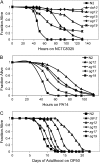DAF-16-dependent suppression of immunity during reproduction in Caenorhabditis elegans
- PMID: 18245330
- PMCID: PMC2248360
- DOI: 10.1534/genetics.107.083923
DAF-16-dependent suppression of immunity during reproduction in Caenorhabditis elegans
Abstract
To further understand how the nematode Caenorhabditis elegans defends itself against pathogen attack, we analyzed enhanced pathogen resistance (epr) mutants obtained from a forward genetic screen. We also examined several well-characterized sterile mutants that exhibit an Epr phenotype. We found that sterility and pathogen resistance are highly correlated and that resistance in both epr and sterile mutants is dependent on DAF-16 activity. Our data indicate that a DAF-16-dependent signaling pathway distinct from previously described pathways is involved in the activation of genes that confer resistance to bacterial pathogens. The timing of DAF-16-dependent gene activation in sterile mutants coincides with the onset of embryonic development in wild-type animals, suggesting that signals from developing embryos normally downregulate the immune response.
Figures








References
-
- Aballay, A., P. Yorgey and F. M. Ausubel, 2000. Salmonella typhimurium proliferates and establishes a persistent infection in the intestine of Caenorhabditis elegans. Curr. Biol. 10 1539–1542. - PubMed
-
- Akira, S., S. Uematsu and O. Takeuchi, 2006. Pathogen recognition and innate immunity. Cell 124 783–801. - PubMed
-
- Arantes-Oliveira, N., J. Apfeld, A. Dillin and C. Kenyon, 2002. Regulation of life-span by germ-line stem cells in Caenorhabditis elegans. Science 295 502–505. - PubMed
-
- Arantes-Oliveira, N., J. R. Berman and C. Kenyon, 2003. Healthy animals with extreme longevity. Science 302 611. - PubMed
-
- Ausubel, F. M., 2005. Are innate immune signaling pathways in plants and animals conserved? Nat. Immunol. 6 973–979. - PubMed
Publication types
MeSH terms
Substances
Grants and funding
LinkOut - more resources
Full Text Sources
Molecular Biology Databases
Research Materials
Miscellaneous

